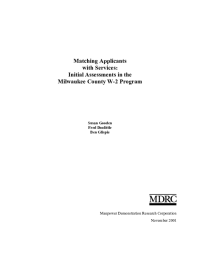Matching Applicants with Services
Initial Assessments in the Milwaukee County W-2 Program
The passage of federal legislation reforming welfare in 1996 challenged states to be innovative in structuring and administering public assistance for needy families with children. As one of the first states to end Aid to Families with Dependent Children (AFDC) and replace it with a new program, Wisconsin provided a new vision for many key decisions that states now face about imposing time limits on assistance (within the federal five-year lifetime limit), setting levels of cash assistance, the variety of employment-related services to offer, and how to enforce requirements for participating in services.
In the Wisconsin Works (W-2) program, applicants for public assistance under Temporary Assistance for Needy Families (TANF) must be assessed and assigned quickly to one of several "tiers" that entail different levels of cash assistance, different services, and different participation requirements. Two tiers (community service jobs and W-2 transitional placements) have two-year limits unless an extension is granted. Thus, caseworkers' decisions about initial tier assignments have important implications for participants and the agencies that administer services. Although state policy sets guidelines for making initial tier assignments, caseworkers have much discretion in designing an individualized service plan for applicants and participants. Moreover, in Milwaukee County, the state has contracted with private agencies to administer W-2, and the agencies have developed their own procedures for conducting intake and assessing applicants.
This report - the first in a series on W-2 administration - describes how the early assessment of applicants' job readiness and service needs was actually done in Milwaukee County during the program's first two years. Based on field research, administrative records, and observations of program operations, it analyzes the initial tier and activity assignments. The study's findings illustrate how W-2 has evolved, how caseworkers have handled the many tasks of enrolling someone in the program, and the challenges of assessing the circumstances and needs of applicants who have serious barriers to employment.
Key findings include:
- Initial tier assignments changed substantially over the first two years of W-2 operations, reflecting changes in state policy, agency practice, and applicants' characteristics. Assignments to community service jobs remained most common throughout the period but did decline over time, whereas W-2T (transitional) assignments increased, as did assignments to a temporary category for parents of newborns. Although agencies do differ in their approach to client assessment, much of the variation reflects differences among caseworkers within agencies.
- Facing large caseloads, mandated deadlines for decisions, and the multiple demands of establishing eligibility for W-2 while also specifying a client's employability plan, caseworkers rely primarily on informal assessment in making initial tier and activity decisions. They are often guided by some simple strategies based on an applicant's extent of education and work experience.
- Caseworkers have no clear road map to guide them in assessing applicants who have multiple, complex, long-term barriers to employment - a goal that seems distant - and this compounds the difficulties of designing an employability plan. In such cases, they may assign initial activities that create an opportunity for more extended, formal assessment.
This research depends on the cooperation of the W-2 service providers in Milwaukee County and the State of Wisconsin Department of Workforce Development and is made possible through the financial support of the Joyce, Rockefeller, Annie E. Casey, and Kellogg Foundations. Upcoming reports will examine W-2's community service jobs component, contracting with service agencies, extensions of time limits, and complaint resolution. The findings of the project will be summarized in a brief synthesis.






